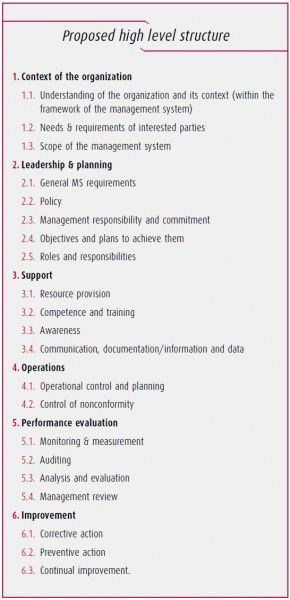What a gem of an article, really. But I don't really see the 9000/9001/9004 process model as being in any way conflicting with the PDCA of 14000, as TC 176 and TC 207 seem to see a conflict. It's just a different picture, really. I've always thought of the process/system model appearing in ISO 9000/9001/9004 as also depicting the PDCA cycle. I don't really think it's a stretch, and I think there must be guidance documents to support it. It seems the PDCA cycle is built into the process model. If you are interested:
Section 4 basically says "you will have a QMS and you will continue to improve it." (And control any documents/records needed by the standard.)
Now, here's where the PDCA meets the process/system model:
Section 5, management review, represents the ACT phase of the PDCA cycle.
So to start with the PLAN phase, we go to Section 6, resource management. Section 6 represents the PLAN quadrant of the PDCA cycle. Resources are supplied to each process, and these resources are configured in a certain way--precisely as they are today. Infrastructure resources supplied to a production process might include: suitable production equipment (machines), competent personnel, defined methods (Travelers, work instructions, etc.), suitable inspection equipment, etc. These resources, taken together, represent the PLAN for how processing will be performed.
Section 7 represents the DO phase of the PDCA cycle. Production is done according to plan--using the provided resources to get the job done.
Section 8 represents the CHECK phase of the PDCA cycle. Section 8 requires measurement of product and processes (for effectiveness and efficiency) to ensure control and to identify opportunity for improvement. Provisions for improvements and corrective / preventive actions are also addressed here, to be employed by top management in . . .
Section 5 Management Responsibility, again represents the ACT phase of the PDCA cycle. It's management's responsibility to take action to adjust the resources supplied to processes, based upon review of performance relative to established objectives. It's management's responsibility to determine what actions to take to address problem performance and seize upon opportunities for improvement as deemed appropriate.
Management might decide to add a step to a checklist or change the order of operations on a Traveler in an effort to improve processing in the future. Even these slight improvements are improvements to the resources available to those performing work. (A modification of the PLAN.)
Management might decide to invest in equipment that increases production throughput, increases ability to hold tighter tolerances, etc. This is an improvement to the resources available to personnel processing work. (A change in the PLAN.)
Management might decide to provide GD&T training to all machinists. This investment is presumably to assure the competence of personnel performing processes--another improvement in resources.
On another note, when management decides to implement lean or six sigma, these efforts are formal efforts to improve processes, or activities within processes, or activities that span processes. Any resulting change to processing as the result of lessons learned from lean, six sigma, etc., are improvements to the QMS and its processes--just as required of the standard. Each change might be construed to be a change to, or improvement of the plan. And then we do it that way. And then we check. And then we act to improve the plan based upon performance. And so it goes. . .


